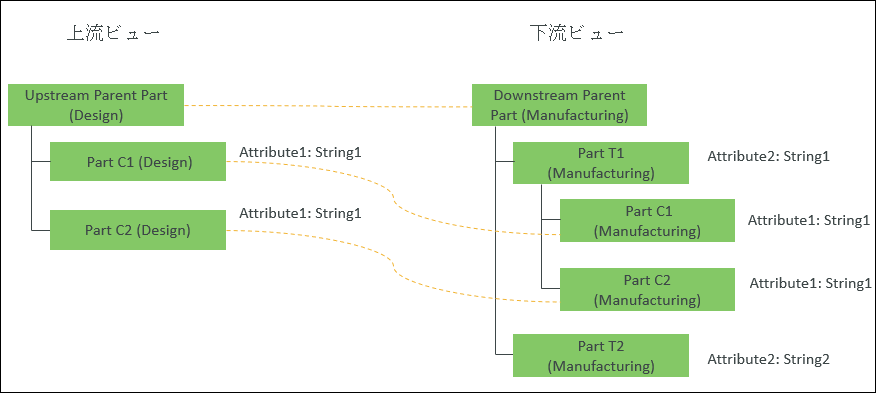ユースケース 6: 2 つの異なる親子関係属性をマッピングすることで下流構造を生成
BOM トランスフォーマに以下の構造が存在するとします。

• Upstream Parent Part (Design) と Downstream Parent Part (Manufacturing) の間に対応リンクが存在します。
複数の異なる親子関係属性をマッピングすることで下流構造を生成するには、規則ファイルまたはプロパティファイルを使用して変換規則と再構築規則を指定できます。
規則ファイルを使用
{
"transformRules": [
{
"sourceType": "wt.part.WTPart",
"newAttributeMappings": [
[
"source.usage.Attribute1:String1",
"target.usage.Attribute2:String1"
]
],
"targetType": "wt.part.WTPart",
"transformOption": "newPart"
}
]
}
"transformRules": [
{
"sourceType": "wt.part.WTPart",
"newAttributeMappings": [
[
"source.usage.Attribute1:String1",
"target.usage.Attribute2:String1"
]
],
"targetType": "wt.part.WTPart",
"transformOption": "newPart"
}
]
}
プロパティファイルを使用
1. Windchill/codebase/com/ptc/core/foundation/associativity にあるファイル associativity.properties.xconf にアクセスします。
2. 以下の再構築規則を追加します。
<Property name="com.ptc.windchill.associativity.reconciliation.addusage.wt.part.WTPartUsageLink" multivalued="," default=""/>
<AddToProperty name="com.ptc.windchill.associativity.reconciliation.addusage.wt.part.WTPartUsageLink" value="transformOption=newPart"/>
<AddToProperty name="com.ptc.windchill.associativity.reconciliation.addusage.wt.part.WTPartUsageLink" value="targetType=wt.part.WTPartUsageLink"/>
<AddToProperty name="com.ptc.windchill.associativity.reconciliation.addusage.wt.part.WTPartUsageLink" value="attributeMapping.rule1=Attribute1:String1:Attribute2:String1"/>
上流で選択した部品に対して  操作を開始すると、選択した部品の下の構造がスキャンされます。このコンフィギュレーションによって以下の処理が行われます。
操作を開始すると、選択した部品の下の構造がスキャンされます。このコンフィギュレーションによって以下の処理が行われます。
 操作を開始すると、選択した部品の下の構造がスキャンされます。このコンフィギュレーションによって以下の処理が行われます。
操作を開始すると、選択した部品の下の構造がスキャンされます。このコンフィギュレーションによって以下の処理が行われます。• 部品親子関係属性 Attribute1 が String1 に設定されている部品が検出された場合、検出された部品は、下流の、部品タイプが wt.part.WTPart で部品親子関係属性 Attribute2 が String1 に設定されている部品の下に、新規部品として追加されます。
BOM トランスフォーマに以下の構造が表示されます。

Part C1 (Manufacturing) および Part C2 (Manufacturing) が Part T1 (Manufacturing) の下に新規部品として追加されます。